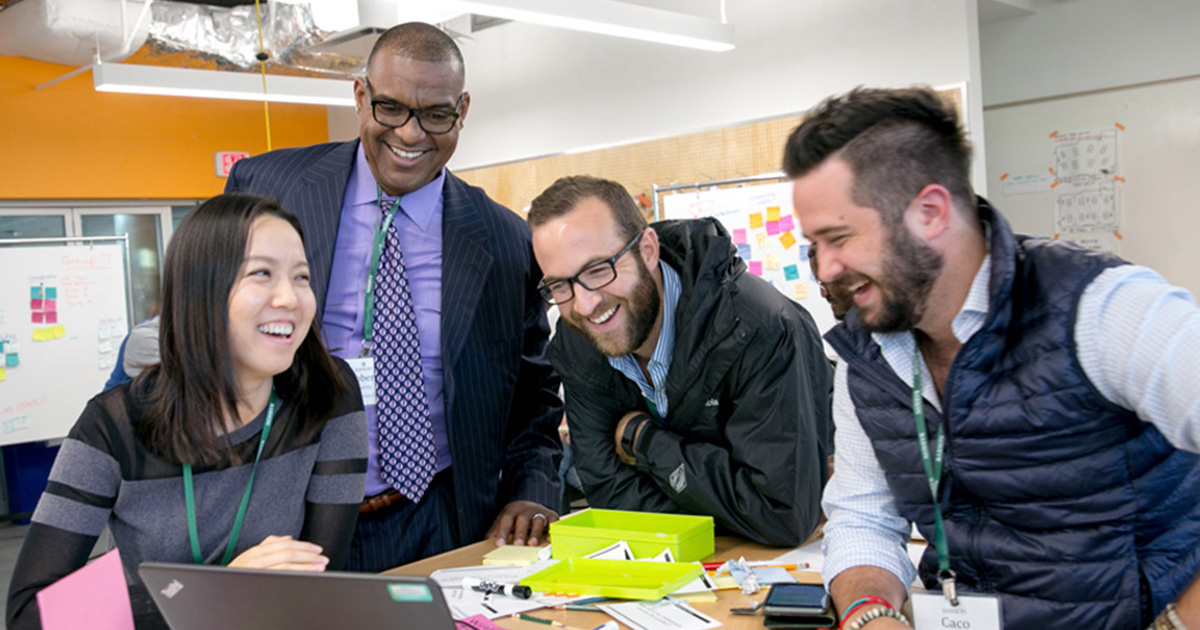Beyond the Buzzword: Why Your Business Needs Design Thinking

First things first: Design thinking isn’t the same thing as design.
Rather, design thinking is “both an effective problem-solving approach and a mindset,” explains Sebastian Fixson, Babson College associate professor and design thinking researcher.
And, for companies using design thinking, it’s much more than a buzzword—it’s an effective path to innovation.
Design Thinking as a Problem-Solving Approach
To illustrate the need for design thinking, Fixson gives this example: in the U.S. today, there are thousands of cereals available. Says Fixson, “Making a cereal a bit crunchier is probably not going to do anything.”
That’s where design thinking comes in: to help companies innovate and develop a strategic advantage within their industry.
Expert Tim Brown’s design thinking model has three steps: inspiration (finding the problem or opportunity), ideation (developing possible solutions), and implementation (testing solutions). Other models have four or five steps but all involve applying user-focused, or human-centered, design to find, identify, and understand the problem and opportunity. “We need to understand what users really need,” says Fixson. “As a famous anthropologist once said, what people say and do, and what people say they do, are entirely different things.”
Here’s an example of design thinking in action: Pepsi hoped a smaller, pink package would help them sell chips to women in Japan. But that hypothesis was incorrect. “When someone took the time to understand how things are consumed,” Fixson reveals, “they found that women like to snack, but the cultural context makes it inappropriate. It’s noisy in an office environment.”
That single insight led to a redesign of the chip to make it smaller and less noisy when crunched. “A deep understanding of user context was the relevant piece—not trivial, surface-level gender associations.”
The implementation stage varies greatly from traditional problem-solving, too. Instead of a full-scale implementation, design thinking is about performing quick tests to see how people respond to the solution. “Let users tell you what’s right and what’s wrong,” says Fixson.
At Blue Cross, Blue Shield of Massachusetts, Molly Mazzaferro, Director of Innovation, is using this approach to get customer feedback as early as possible. “[We could] spend months, years building something only to find you’re solving the wrong problem,” she explains.
“That’s where the power of design thinking lies: the time and attention to understand users in a deeper way,” Fixson said. “Having a better idea of the problem allows you to develop a better solution.” And, implementing small tests lets you fail fast and iterate quickly.
Design Thinking as a Mindset
Another important note: design thinking is a mindset that requires patience.
“We all tend to want to develop solutions quickly,” empathizes Fixson. But for design thinking to work, you’ve got to focus on finding the problem. “It takes patience and a willingness to suspend solution generation for a while and focus on identifying the problem first. Accept not having the question yet. That’s a mental problem for many of us.”
The mindset also requires a shift in the perception of failure; taking the time to observe, learn, and understand the actual problem.
Instead, companies need to strike a balance between the two mindsets. “There are three characteristics a product needs to be successful: it needs to be desirable, technically feasible, and economically viable,” Fixson explains. While most companies are good at assessing technical and economic viability, they’ve lost touch with the details and emotions of customers. And, that emotional element may lead to a completely different—more effective—solution.
Mazzaferro believes the mindset is equally (if not more) important than the process. “For us, it’s about being human-centered and bringing the customer into the conversation,” she explains. “That’s not traditionally how we’ve approached problem solving.”
Her team also utilizes “radical collaboration”—bringing in provider partners, government agencies, students in the Boston area, and doctors. “We want to bring all these voices to the table for everything from problem identification through solution development.”
Developing a New Mindset
Understanding design thinking is just the beginning. For design thinking to work, a company’s culture must support experimentation. “In many companies, traditional evaluation methods would quickly suggest some of it is wasteful,” points out Fixson. “Most budgeting methods are good at measuring costs, but poor at measuring missed opportunities. There’s no way of putting a dollar sign on an opportunity you didn’t find a solution for.”
There’s also the issue of time. “You’ve spend X hours and haven’t produced something yet,” Fixson says. “Using design thinking on every project may be wasteful. But, on the other hand, if your goal is to think about a new or better solution, then the question becomes can your organization find a way to spend time and attention to rethink the problem?”
For Mazzaferro, it’s getting people to “fall in love with the problem. It’s human nature to fall in love with the solution before you know it’s the right thing,” she explains.
Taking the First Step
“Every company has a different approach, and it depends on how deeply they want to embed design thinking into their way of working,” says Fixson. Some organizations are hiring designers in leadership roles. Others are training large swaths of employees in design thinking, while still others are hiring design consultancies on a project basis.
At Blue Cross Blue Shield, Mazzaferro’s team was born out of a project that recommended what innovation could and should look like at the company. Dedicated to innovation, the team is charged with two things: increasing incremental innovation and pursuing more disruptive ideas.
“Part of it is arming employees with the tools and mindset to work differently on a day-to-day basis,” explains Mazzaferro. This cultural change piece is slow, steady work for a company filled with employees that have been there for many years. “Change is harder the longer you are someplace doing things the same way.”
“The other side of our work is thinking about health insurance and the rapid changes happening in the industry,” Mazzaferro continues, citing provider consolidation, startup activity, and possible changes due to the current political administration. “Health insurance won’t look the same in five years, and definitely not in 10 years, how can we think about healthcare more broadly than insurance?”
Now five members strong, the Innovation team at BCBSMA is sharing the design thinking methodology across her organization with a curriculum which includes a 90-minute crash courses and two-day bootcamps, programming developed with the help of Fixson. In each session, teams experience every step of the process, trying on different behaviors and mindsets. After attending a bootcamp, associates receive a black bracelet that says “catalyst.” “It’s a small symbol to show they’re empowered to start using the design thinking mindset,” explains Mazzaferro.
Some boot camps have rolled into sprints for deeper exploration of a business problem; eventually, those sprints will form the basis of a full incubator program. The Innovation team also helps anyone in the business set up user testing parties to test emerging ideas with actual customers. To date, they’ve touched over one-third of the organization with the design thinking process, always bringing in individuals from outside the organization to demonstrate the radical collaboration idea. The team’s ultimate goal is to build an innovation center—a dedicated physical space where unlikely partners collaborate for better health.
So far, Mazzaferro has seen Post-it notes up on walls of the insurance provider’s offices, something she hadn’t seen before. “The buzz is growing. It’s felt like we’ve been doing it forever, but it’s only been a year and a half. We have to be patient,” she says. “Some people are never going to be comfortable with it. But we keep marching on.”
Posted in Insights






